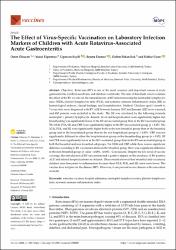The Effect of Virus-Specific Vaccination on Laboratory Infection Markers of Children with Acute Rotavirus-Associated Acute Gastroenteritis
Künye
[Okuyan, Omer; Isik, Ozlem Erkan] Istanbul Atlas Univ, Med Hosp, Dept Pediat, TR-34408 Istanbul, Turkiye; [Elgormus, Yusuf] Med Hosp, Clin Pediat, TR-34408 Istanbul, Turkiye; [Sayili, Ugurcan] Istanbul Univ Cerrahpasa, Cerrahpasa Fac Med, Dept Publ Hlth, TR-34098 Istanbul, Turkiye; [Dumur, Seyma; Uzun, Hafize] Istanbul Atlas Univ, Fac Med, Dept Med Biochem, TR-34408 Istanbul, TurkiyeÖzet
Objective: Rotavirus (RV) is one of the most common and important causes of acute gastroenteritis (AGE) in newborns and children worldwide. The aim of this study was to evaluate the effect of the RV vaccine on the natural history of RV infections using the neutrophil-lymphocyte ratio (NLR), platelet-lymphocyte ratio (PLR), and systemic immune inflammatory index (SII) as hematological indexes, clinical findings, and hospitalization. Method: Children aged 1 month to 5 years who were diagnosed with RV AGE between January 2015 and January 2022 were screened, and 630 patients were included in the study. The SII was calculated by the following formula: neutrophil x platelet/lymphocyte. Results: Fever and hospitalization were significantly higher and breastfeeding was significantly lower in the RV-unvaccinated group than in the RV-vaccinated group. The NLR, PLR, SII, and CRP were significantly higher in the RV-unvaccinated group (p < 0.05). The NLR, PLR, and SII were significantly higher both in the non-breastfed group than in the breastfed group and in the hospitalized group than in the not hospitalized group (p < 0.05). CRP was not significantly different in either the hospitalization group or the breastfeeding group (p > 0.05). SII and PLR were significantly lower in the RV-vaccinated group than in the RV-unvaccinated group in both the breastfed and non-breastfed subgroups. For NLR and CRP, while there was no significant difference according to RV vaccination status in the breastfed group, there was a significant difference in the non-breastfed group (p value: <0.001; <0.001). Conclusions: Despite the low level of vaccine coverage, the introduction of RV vaccination had a positive impact on the incidence of RV-positive AGE and related hospitalizations in children. These results showed that breastfed and vaccinated children were less prone to inflammation because their NLR, PLR, and SII ratios were lower. The vaccine does not prevent the disease 100%. However, it can prevent severe disease with exsiccation or death.

















